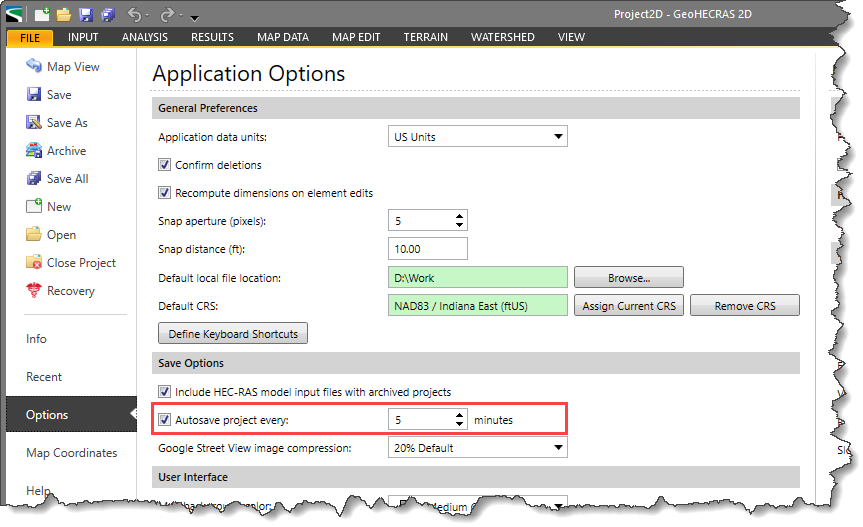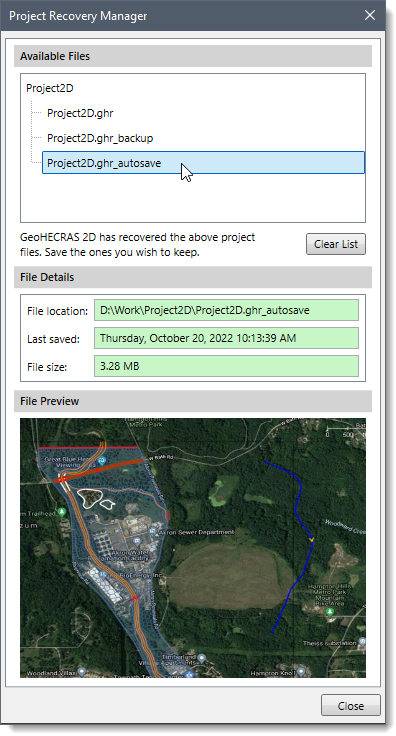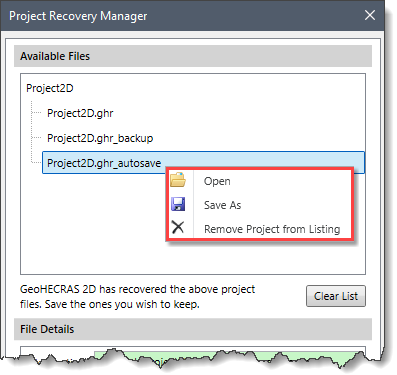A hardware problem, power failure, or software problem can cause the program to terminate unexpectedly. This article describes how the Project Recovery Manager can help the user recover project data in the event of the aforementioned occurring.
Note that the recovery of a project will only be possible if the user has an autosave feature set in the software. If the autosave option is enabled, then the user can retrieve the latest saved copy of the project from the default save location. By default, CivilGEO software creates a backup file when saving and initiates an autosave process every 5 minutes.
The user can enable/disable and set the time interval for the autosave feature in the “Autosave project every” checkbox entry field from the Option backstage page as shown below.

Project Recovery Manager
The Project Recovery Manager helps with the task of locating and opening projects that were last open when the software crashed, as well as any backup and autosave files associated with those projects.
When the user launches the software after a crash, the Project Recovery Manager dialog box will automatically be displayed. Alternatively, the user can also display this dialog box by selecting the Recovery command from the File ribbon menu.

The Project Recovery Manager dialog box determines which projects were active when the crash occurred and displays those projects and the associated backup and autosave files in a single, easy-to-use interface.

The Project Recovery Manager dialog box contains three sections, which are described below:
- Available Files
This section displays the list of available project files that can be recovered.
- File Details
This section displays the details of the file location, the last autosaved project file date and time, and the size of the file.
- File Preview
This section displays the preview of the selected project file in the Available Files section.
Using the Project Recovery Manager, the user can open backup and autosave files directly without having to manually locate and rename the files. The first time a user attempts to save a backup or autosave file, the user will be prompted to rename the file.
To open a file from the listing, either double-click on the file or right-click and choose Open from the displayed context menu. To rename or save a file from the listing, right-click and choose Save As from the displayed context menu. To remove a file from the listing, right-click and choose Remove Project from Listing from the displayed context menu.

Clicking the [Clear List] button clears all the listed project files from the Available Files section and closes the dialog box.
Notes:
- The project, backup, and autosave files are listed in the order that they were last saved.
- The Project Recovery Manager is only useful after a crash has occurred and will only display information about project files that were active during a session that crashed. You cannot launch the Project Recovery Manager during a normal working session and have it show you the backup and autosave files for the current project.
Send an Error Report Automatically to CivilGEO
If the program encounters a problem and closes unexpectedly, the software will display an error report dialog box. The user can choose to send the error report to CivilGEO in order to help our software developers diagnose problems with the software. The error report includes information about the state of the user system at the time the error occurred. The user can also add other information, such as details relating to what the user was doing at the time of the error.
